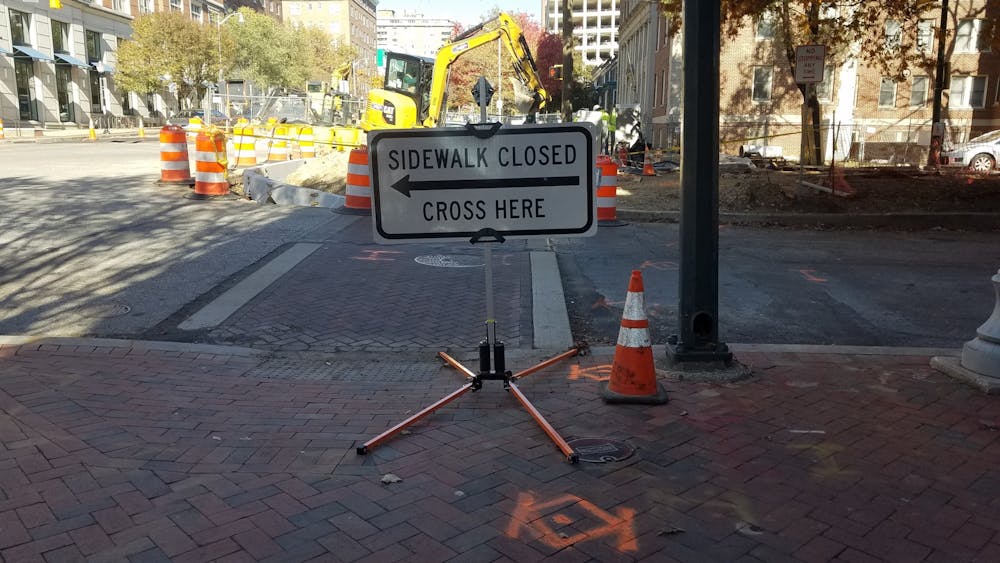It’s always an exciting time when new construction happens around campus. Is it going to be a new restaurant? A bar? It is exciting, at least, for those not potentially displaced by it.
As I walk around Charles Village, I’m struck by the level of construction happening throughout the neighborhood. It seems the current major project is finally making two blocks of Saint Paul Street more safe for pedestrians — whose great idea was it to make it otherwise in the first place?
This is one of many projects slated by the city and the University in the near future. It made me think: If safely navigating the areas under construction are troublesome for me, how are our brothers and sisters in the community with physical disabilities — those in Charles Village and beyond — dealing with it? Is there any representation of this community on the appropriate boards and commissions?
Would the entire sidewalk be blocked off and require someone to endure what would normally be considered a treacherous walk on the side of the road if there was such representation? One would hope not. For someone who can walk without any assistance, it’s not as much of a problem, although it’s still unsafe. But what about for someone who requires a wheelchair or a walker? Or a parent with a child stroller, for that matter?
What is a minor bother for many of us can be an even riskier one for others. I’d like to believe that the relevant communities and organizations were consulted, so that much of this could be avoided or at least mitigated.
After scouring both the Hopkins and city websites, that doesn’t seem to be the case. In my search, I only saw one mention of the disabled community, and that was in the 2012 Development Guidebook for Baltimore City. Under the section titled “Site Plan Review,” it indicates that agencies included in the membership of the Site Plan Review Committee will include the Mayor’s Office of Disabilities. While that is commendable, it’s imperative that transparency and accountability are integral to every step of the construction process.
I’m as guilty as the next when it comes to failing to remain cognizant of the egregiously discriminatory nature of our built environment. There was a history of redlining in Baltimore in the 1930s which continues to affect neighborhoods today. There are also failing water and public utility systems (comparable to Flint, Mich. and Pacific Gas and Electric of California), as well as unreliable public transportation and collapsing roads.
I reap the privilege of not living with a disability, and I reside in a majority-white neighborhood of Baltimore, which happens to be largely segregated. While realizations like mine may be fleeting thoughts on a Monday morning as I walk to the JHMI shuttle, there are those among us who are forced to live with these interruptions in their everyday lives. Be it their daily commute or a simple Sunday stroll to the library, there remains a lack of recognition and understanding as to the real impacts of construction and development, such as those in Charles Village.
I recently vocalized these observations with a friend of mine. He took a moment to think and then promptly responded, “It’s only for a few months, it can’t be that bad.” And while yes, I should probably reconsider that friendship (I promise he’s not always that terrible), it made me realize this mindset is more pervasive than I may allow myself to believe.
The inconvenience of the construction may only be temporary for me, but it should lead all of us to reflect and recognize the disruption that inequitable infrastructure imposes on the everyday lives of our friends, family and neighbors.
What remains to be seen is whether Hopkins, and the city more broadly, will center the voices of those who would otherwise not be represented in these spaces. They must consider what the true cost of development will be for our neighbors, in the interim and beyond.
The disabled community is far from the only one affected in all of this construction and development — there are also the growing levels of gentrification in the city, failing roads and crumbling buildings. Yet those who reap the major benefits of this growth and development are not the ones who need it (let alone deserve it). The ones who need it are often victim to it.
Tyler Adamson is a graduate student at the Bloomberg School of Public Health from Vancouver, Washington.





